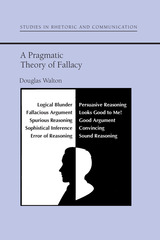2 books about Fallacies (Logic)

The Corps and the Shore
Orrin H. Pilkey and Katharine L. Dixon
Island Press, 1996
For more than a century, the U.S. Army Corps of Engineers has been building fortifications along the American coastline in an effort to protect our vulnerable shores. With the prospect of seaborne invasion becoming increasingly unlikely, the Corps has turned its attention to a more subtle but no less dangerous threat: the insidious effects of coastal erosion.In The Corps and the Shore, Orrin H. Pilkey, the nation's most outspoken coastal geologist, and Katharine L. Dixon, an educator and activist for national coastal policy reform, provide a comprehensive examination of the impact of coastal processes on developed areas and the ways in which the Corps of Engineers has attempted to manage erosion along America's coastline.Through detailed case studies of large-scale projects in Texas, Maine, Pennsylvania, North Carolina, and South Carolina, the authors demonstrate the shortcomings of the Corps's underlying assumptions and methodology. As they discuss the role of local citizens in the project process, they highlight the interaction between local Corps offices and community officials and residents. By focusing on different types of problems in various regions of the country, Pilkey and Dixon clearly show how the Corps has repeatedly failed to act in the best interest of those most affected by the projects. As well as criticizing Corps practices, the authors provide numerous suggestions for reforming the Corps and making it both more scientifically accountable and more accountable to the citizens it is intended to serve.The Corps and the Shore is essential reading for coastal residents, environmentalists, planners, and coastal city officials as well as geologists, civil engineers, marine scientists, and anyone concerned with the impact of human society on our shorelines.
[more]

A Pragmatic Theory of Fallacy
Douglas Walton
University of Alabama Press, 1995
Takes a new analytical look at the concept of fallacy and presents an up-to-date analysis of its usefulness for argumentation studies
Although fallacies have been common since Aristotle, until recently little attention has been devoted to identifying and defining them. Furthermore, the concept of fallacy itself has lacked a sufficiently clear meaning to make it a useful tool for evaluating arguments. Douglas Walton takes a new analytical look at the concept of fallacy and presents an up-to-date analysis of its usefulness for argumentation studies. Walton uses case studies illustrating familiar arguments and tricky deceptions in everyday conversation where the charge of fallaciousness is at issue.
The numerous case studies show in concrete terms many practical aspects of how to use textual evidence to identify and analyze fallacies and to evaluate arguments as fallacious. Walton looks at how an argument is used in the context of conversation. He defines a fallacy as a conversational move, or sequence of moves, that is supposed to be an argument that contributes to the purpose of the conversation but in reality interferes with it. The view is a pragmatic one, based on the assumption that when people argue, they do so in a context of dialogue, a conventionalized normative framework that is goal-directed. Such a contextual framework is shown to be crucial in determining whether an argument has been used correctly. Walton also shows how examples of fallacies given in the logic textbooks characteristically turn out to be variants of reasonable, even if defeasible or questionable arguments, based on presumptive reasoning. This is the essence of the evaluation problem. A key thesis of the book, which must not be taken for granted as previous textbooks have so often done, is that you can spot a fallacy from how it was used in a context of dialogue. This is an innovative and even, as Walton notes, "a radical and controversial" theory of fallacy.
Although fallacies have been common since Aristotle, until recently little attention has been devoted to identifying and defining them. Furthermore, the concept of fallacy itself has lacked a sufficiently clear meaning to make it a useful tool for evaluating arguments. Douglas Walton takes a new analytical look at the concept of fallacy and presents an up-to-date analysis of its usefulness for argumentation studies. Walton uses case studies illustrating familiar arguments and tricky deceptions in everyday conversation where the charge of fallaciousness is at issue.
The numerous case studies show in concrete terms many practical aspects of how to use textual evidence to identify and analyze fallacies and to evaluate arguments as fallacious. Walton looks at how an argument is used in the context of conversation. He defines a fallacy as a conversational move, or sequence of moves, that is supposed to be an argument that contributes to the purpose of the conversation but in reality interferes with it. The view is a pragmatic one, based on the assumption that when people argue, they do so in a context of dialogue, a conventionalized normative framework that is goal-directed. Such a contextual framework is shown to be crucial in determining whether an argument has been used correctly. Walton also shows how examples of fallacies given in the logic textbooks characteristically turn out to be variants of reasonable, even if defeasible or questionable arguments, based on presumptive reasoning. This is the essence of the evaluation problem. A key thesis of the book, which must not be taken for granted as previous textbooks have so often done, is that you can spot a fallacy from how it was used in a context of dialogue. This is an innovative and even, as Walton notes, "a radical and controversial" theory of fallacy.
[more]
READERS
Browse our collection.
PUBLISHERS
See BiblioVault's publisher services.
STUDENT SERVICES
Files for college accessibility offices.
UChicago Accessibility Resources
home | accessibility | search | about | contact us
BiblioVault ® 2001 - 2024
The University of Chicago Press









